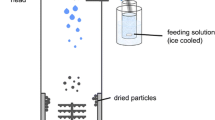Abstract
The ratio of hydroxyapatite (HA) nanoparticles (NP) to trehalose in composite microparticle (MP) vaccine vehicles by determining inter-nanoparticle space potentially influences antigen release. Mercury porosimetry and gas adsorption analysis have been used quantify this space. Larger pores are present in MPs spray dried solely from nanoparticle gel compared with MPs spray dried from nanoparticle colloid which have less inter-nanoparticle volume. This is attributed to tighter nanoparticle packing caused by citrate modification of their surface charge. The pore size distributions (PSD) for MP where the trehalose has been eliminated by combustion generally broaden and shifts to higher values with increasing initial trehalose content. Modal pore size, for gel derived MPs is comparable to modal NP width below 30% initial trehalose content and approximates to modal NP length (~50 nm) at 60% initial trehalose content. For colloidally derived MPs this never exceeds the modal NP width. Pore-sizes are comparable, to surface inter-nanoparticle spacings observed by SEM.


















Similar content being viewed by others
References
Motskin M, Wright DM, Muller K, Kyle N, Gard TG, Porter AE, et al. Hydroxyapatite nano and microparticles: correlation of particle properties with cytotoxicity and biostability. Biomaterials. 2009;30:3307–17.
Wright DM, Rickard JJ, Kyle N, Gard T, Dobberstein H, Motskin M, et al. The use of dual beam ESEM FIB to reveal the internal ultrastructure of hydroxyapatite nanoparticle-sugar-glass composites. J Mater Sci Med. 2009;20:203–14.
Midgley PA, Dunin-Borkowski RE. Electron tomography and holography in materials science. Nat Mater. 2009;8:271–80.
Joyner LG, Barrett EP, Skold R. The determination of pore volume and area distribution in porous substances. Comparison between nitrogen isotherm and mercury porosimeter methods. J Am Chem Soc. 1951;73:3155–8.
Washburn EW. The dynamics of capillary flow. Phys Rev. 1921;17:273–83.
Rouquerol J, Avnir D, Fairbridge CW, Everett DH, Haynes JH, PErnicone N, et al. Recommendations for the characterization of porous solids. Pure Appl Chem. 1994;66:1739–58.
Diamond S. A re-evaluation of hardened cement paste microstructure based on backscatter SEM investigations. Cem Concr Res. 2000;30:1517–25.
Tuan Ho S, Hutmacher DW. A comparison of micro CT with other techniques used in the characterization of scaffolds. Biomaterials. 2006;27:1362–76.
Padilla S, Román J, Vallet-Regí M. Synthesis of porous hydroxyapatites by combination of gelcasting and foams burn out methods. J Mater Sci Med. 2002;13:1193–7.
Kaneko K. Determination of pore size and pore size distribution 1. Adsorbents and catalysts. J Membr Sci. 1994;96:59–89.
Webb PA, Orr C. Analytical methods in fine particle technology, Micromeritics; 1997.
Brunauer S, Emmett PH, Teller E. Adsorption of gases in multimolecular layers. J Am Chem Soc. 1938;60:309–19.
Barrett EP, Joyner LG, Halenda PP. J Am Chem Soc. The determination of pore volume and area distribution in porous substances. I. Computations from nitrogen isotherms. 1951;73:373–80.
Cracknell RF, Gubbins KE, Maddox M, Nicholson D. Behavior in well-characterized porous materials. Acc Chem Res. 1995;28:281–8.
Kumta PN, Sfeir C, Lee DH, Olton D, Choi D. Nanostructured calcium phosphates for biomedical applications: novel synthesis and characterization. Acta Biomater. 2005;1:65–83.
Groen JC, Peffer LAA, Perez-Ramirez J. Pore size determination in modified micro- and mesoporous materials. Pitfalls and limitations in gas adsorption data analysis. Microporous Mesoporous Mater. 2003;60:1–17.
Ciftcioglu M, Smith DM, Ross SB. Mercury porosimetry of ordered sphere compacts: Investigation of intrusion and extrusion pore size distributions. Powder Technol. 1988;55:193–205.
Portsmouth RL, Gladden LF. Determination of pore connectivity by mercury porosimetry. Chem Eng Sci. 1991;46:3023–36.
Jiang W, Pan H, Cai Y, Tao J, Liu P, Xu X, et al. Atomic force microscopy reveals hydroxyapatite-citrate interfacial structure at the atomic level. Langmuir. 2008;24:12446–51.
Bertinetti L, Tampieri A, Landi E, Ducati C, Midgley PA, Coluccia S, et al. Surface structure, hydration, and cationic sites of nanohydroxyapatite: UHR-TEM, IR, and microgravimetric studies. J Phys Chem C. 2007;111(10):4027–35.
Drouet C, Bosc F, Banu M, Largeot C, Combes C, Dechambre G, et al. Nanocrystalline apatites: from powders to biomaterials. Powder Technol. 2009;190(1–2):118–22.
Chow LC, Sun LM, Hockey B. Properties of nanostructured hydroxyapatite prepared by a spray drying technique. J Res Natl Inst Stand Technol. 2004;109(6):543–51.
Colilla M, Manzano M, Vallet-Regi M. Recent advances in ceramic implants as drug delivery systems for biomedical applications. Int J Nanomed. 2008;3:403–14.
CHen LH, Zhu GS, Zhang DL, Zhao H, Guo MY, Wei SB, et al. Novel mesoporous silica spheres with ultra-large pore sizes and their application in protein separation. J Mater Chem. 2009;19(14):2013–7.
Acknowledgments
This work was funded by a DTI grant (CHBS/004/00063C) held jointly by J. N. Skepper at the University of Cambridge and Cambridge Biostability Ltd. We would like to thank Wayne Hough for his assistance in running samples for Mercury Porosimetry and Dr. Serena Best for access to equipment run within her laboratory.
Author information
Authors and Affiliations
Corresponding author
Rights and permissions
About this article
Cite this article
Wright, D.M., Saracevic, Z.S., Kyle, N.H. et al. The mesoporosity of microparticles spray dried from trehalose and nanoparticle hydroxyapatite depends on the ratio of nanoparticles to sugar and nanoparticle surface charge. J Mater Sci: Mater Med 21, 189–206 (2010). https://doi.org/10.1007/s10856-009-3858-2
Received:
Accepted:
Published:
Issue Date:
DOI: https://doi.org/10.1007/s10856-009-3858-2




